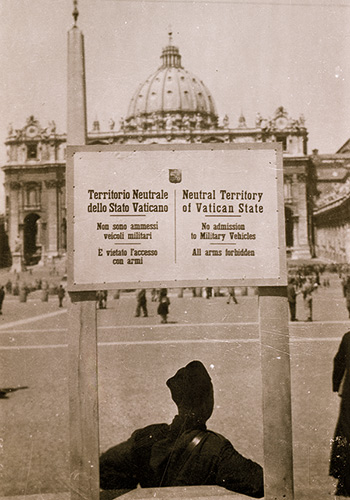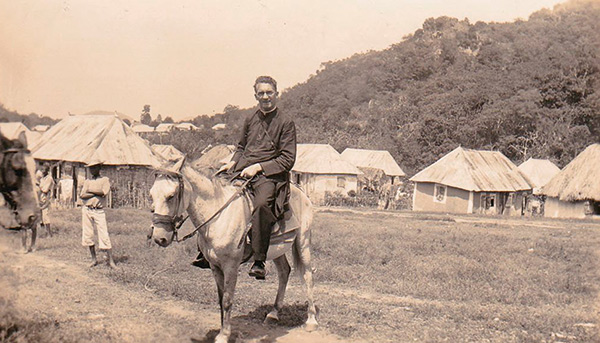Subtotal: $
Checkout-

Do Activists Need Enemies?
-

The Making of Martyrs
-

Visions of the Kingdom
-

Foolhardy Wisdom
-

Tough Love on the Mount
-

Walls behind Bars
-

My Mind, My Enemy
-

Demining the Sahara
-

Just Doing What Christians Do
-

Hating Sinners
-

Students Brave the Heat
-

A Russian Christian Speaks Out
-

The Witching Hour
-

Enemy Lovers
-

How God Sees Us
-

Macedonia Morning
-

Tim Keller: New York’s Pastor
-

What Is Time For?
-

Poem: “South Head, a Wild Surmise”
-

Poem: “Lammergeier”
-

Poem: “World Within”
-

When Love Seems Impossible
-

Places to Think with Neighbors
-

Letters from Readers
-

Covering the Cover: The Enemy
-

Thanksgiving Starts in September

The Monsignor versus the Fascists
In and around the Vatican, Hugh O’Flaherty organized a daring network to hide Jews and escaping prisoners of war.
By Maureen Swinger
September 23, 2023
Two men clad in a monsignor’s signature black and scarlet glided slowly across the Piazza di Circo Neoniani, past the Swiss Guard and the Italian gendarmes, murmuring devoutly and certainly not turning their heads to scout for Gestapo soldiers. “Mind now, me boy, walk slowly … none of that parade ground strut! Keep your head bowed, and pray all the time. If you don’t know any prayers, keep your lips moving anyway!” Monsignor Hugh O’Flaherty had lent his spare cassock, and now was lending his urgent advice to Major Sam Derry of the British Royal Artillery, thrice-escaped prisoner of war and now another O’Flaherty conspirator.
Hugh O’Flaherty’s childhood was spent in Killarney, Ireland. Hearing a distinct call to the priesthood, he was worried about telling his father, knowing the state of the family finances. So he employed his sister Bride to break the news. Their father’s response: “I would sell the house to make a priest of him.”

A German Panzer tank in front of the Altare della Patria in Rome, February 1944. Photograph from Wikimedia (public domain).
O’Flaherty enrolled at the Jesuits’ Mungret College near Limerick, where by all accounts he did well in his studies, but better at golf, boxing, handball, and hurling. Posted to Rome in 1922, just as Mussolini was rising to power, he was ordained in 1925 and continued his studies. Drawn into Vatican service, his life as a diplomat took him to Egypt, then Haiti and Santo Domingo, then Czechoslovakia.
By 1938 he was recalled again to Rome, to an appointment in the Sacred Congregation of the Holy Office: what was once the Inquisition. Now he was mingling with Roman society, invited to galas and operas. He joined the Rome Golf Club, which earned him the moniker “the golfing priest.”
Declaring allegiance to the Axis Powers in June 1940, Mussolini sent shock waves through Italy; with armies and armaments depleted after years of conflict in Africa and Albania, the country was not united behind their leader’s actions. But war was at their doorstep anyway.
O’Flaherty’s office was assigned the duty of visiting thousands of Allied prisoners of war in camps scattered across northern Italy, to verify fair treatment. He took down names and details, then, back in Rome, had them broadcast over the Radio Vatican to notify next of kin that their relatives were alive.
On his visits to the camps, he brought Red Cross parcels, prayer books, and cigarettes, and lobbied to increase the number of doctors and chaplains available. Eventually these actions got him removed from the job, though not before he filed complaints about two commanders who were dealing out especially cruel treatment to prisoners. His visits had also served another purpose; his name and face were recognized by many who later escaped to Rome.
And then came a new task: not, this time, one to which he was officially assigned, except perhaps by Providence.

A soldier sits at the entrance to the Vatican, 1944. Photograph by John Alden Rusch Jr. Photograph from the Digital Collections of the National World War II Museum. Used by permission.
O’Flaherty was lodged at the German College. Though not within the confines of the Vatican, it was Vatican property and therefore under its protection of neutrality, immune from searches by Mussolini’s men and, later, the Gestapo.
It started small. Jewish families and others endangered by the regime were quietly routed first to O’Flaherty’s lodgings, then to convents and hostels run by trusted acquaintances. Soon POW camp escapees started showing up in St. Peter’s Square, begging for sanctuary. When the Allies invaded Sicily, Mussolini’s regime toppled and Italy surrendered in July 1943; the trickle of escapees became a flood, as the Third Reich moved south to claim the camps and ship the prisoners north.
Pope Pius XII’s predecessor had engineered a blanket of neutrality over the Vatican and its properties, but, not wishing to compromise his diplomatic standing, Pius refused to lift the blanket in order to give sanctuary to refugees. The Swiss Guard were told to refuse entry to all seeking refuge in the city-state.
The pope likely knew about O’Flaherty’s rapidly branching covert pipeline, but he never shut it down. The priest was called in at one point. He never revealed what was said to him.
Whatever it was, O’Flaherty interpreted it as, “Be more sneaky.” From his post of observation on the steps of St. Peter’s Square, he intercepted each small party of sanctuary seekers before they reached the Swiss Guard, and coworkers helped scatter them throughout the city in safe houses. They managed to hide people in an Italian police barracks for months. Another hideout was directly adjacent to the Rome SS headquarters. Some of the squad impersonated priests, soldiers, and delivery men. Others smuggled fugitives under loads of cabbages destined for German commissaries. One group “borrowed” the uniform of the Swiss Guard and tagged along at the end of the midnight changing-of-the-guard, then kept on marching. Many of the city’s trolley-car operators were in on the operation.

Monsignor Hugh O’Flaherty in Haiti. Photograph courtesy of the Hugh O’Flaherty Memorial Society.
All who joined the venture knew there was someone pulling the network together. He was known to them as Golf (not the most original code name, but it held). Some of the most stalwart members were escapees. One early addition to the ranks was Princess Nini Pallavicini, of one of Rome’s noble families, whose vocal disapproval of Mussolini’s government had brought her under suspicion. When the police traced illegal radio broadcasts to Nini’s palazzo, she escaped the raid by jumping out of a window. O’Flaherty tucked her away in the German College, where she ran a successful document-forging operation for the remainder of the war.
By November 1943, the nameless organization had hidden away over a thousand persons. After safe cover, the most urgent need was money. O’Flaherty approached D’Arcy Osborne, a golfing acquaintance and the twelfth Duke of Leeds and British Minister to the Holy See.
Osborne turned him down; he knew he was being watched. From Osborne’s journal: “While guests of the pope, we are at the same time to some extent prisoners of the Italian government.”
Shortly thereafter, the minister privately contacted O’Flaherty to assure him of as much financial support as he personally was able to secure. Even better, he offered the services of his butler, John May, whom O’Flaherty was to describe as “indispensable, a genius, the most magnificent scrounger I have ever come across.” Discreet and completely loyal, May ran strategies from within the British ambassador’s offices inside the Vatican.
Osborne – code name Mount – threw his untraceable resources at the organization throughout the duration of the war. Upon meeting Major Sam Derry at a social function (Derry still helpfully disguised as a monsignor), Osborne approved his addition to the team; subsequently Derry took on much of the communication with Allied soldiers, and ran espionage forays on the side. (Derry’s false papers, courtesy of Princess Nini and team, declared him an Irish writer employed by the Vatican.)

A portrait sketch of Monsignor Hugh O’Flaherty believed to have been drawn while he was at the Vatican after his time in Haiti and San Domingo, ca. 1936. Artist unknown. Photograph courtesy of the Hugh O’Flaherty Memorial Society.
This network was operating under a regime of martial law, patrolled streets, wiretapped phones, and paid informers. There were betrayals: members were captured and tortured. Most kept their silence, but it was impossible for the rest to know, so each capture necessitated a quiet, desperate flurry of moves to get people to the next haven.
One man in particular honed in on O’Flaherty as a danger to the Reich. Herbert Kappler, chief of the German police and security service in Rome, set the full power of his SS detail on the trail of the elusive monsignor. They set up a comprehensive stalking program to try to catch O’Flaherty on the wrong side of the wide white line painted around the Vatican safety zone, with plans for immediate torture and execution to follow.
That the priest knew he was a target and still calmly took up his scouting post below the basilica in plain view of the SS patrol enraged Kappler. When the flat black hat disappeared, Kappler’s men scattered around the perimeter to see where he would surface. But they never seemed to catch on that a coal-man, street sweeper, or – on one or two rumored occasions – a six-foot-two-inch nun might be their person of interest. “He was so charming and for his own safety he couldn’t care a damn,” recalled Derry.
Kappler’s mandate was the obliteration of Roman Jews; he had captured just over two thousand, of whom hardly more than a dozen escaped Auschwitz. So the underground rescue network redoubled its efforts to protect Jews still at liberty. They hid children in religious houses and gave parents false papers.
On at least three documented occasions, Kappler was within snatching distance of his prey; once the man who was supposed to betray O’Flaherty, a former member of his organization, had a last-second change of heart; he looked up into the priest’s eyes, and then dodged down a side street. Twice, the monsignor received tip-offs; the last plot included two SS “Mass attendees” who were to follow O’Flaherty out the church door and hustle him across the white line where he could be “shot while attempting escape.” John May got wind of that plan, and as the two men stood up after Mass, four Swiss Guards closed in on them. The monsignor continued to hold Mass at the church.
When Allied troops finally marched into Rome on June 4, 1944, the organization had 3,925 escapees in its active care. Postwar research brought the total number aided to approximately 6,500. Meanwhile, O’Flaherty began helping injured Italians and others who had fought for the Axis powers. When called out for “switching sides” he replied, “God has no country.”
He didn’t care much for the tributes that came his way as his exploits were made known by those who had witnessed them. He never collected his pension awarded by the Italian government. But he did do something else. Every month he stopped by a prison between Naples and Rome where he was the only visitor for one particular inmate: former SS officer Herbert Kappler, convicted of war crimes (most notably the Ardeatine Caves massacre) and sentenced to life in prison. Several years after the war, Kappler requested baptism into the Catholic faith, and O’Flaherty fulfilled his request.
Already a subscriber? Sign in
Try 3 months of unlimited access. Start your FREE TRIAL today. Cancel anytime.





































Julia or Toni Smith
Such a interesting article! Would make a great movie
Elmer
An excellent work by this man, moved by his convictions. War brings so much pain to people's lives
Scott
Perfect timing. Two days ago I started the book “ Hide & Seek: The Irish Priest In The Vatican Who Defied The Nazi Command”
Maureen Swinger
Yes, to answer the question above - "The Scarlet and the Black" is an excellent representation of the Hugh O'Flaherty story. It elides some characters and events, as film does, but on the whole, it is historically accurate and won an Emmy in 1983.
Michael Nacrelli
Was this story the basis for "The Scarlet and the Black" movie with Gregory Peck?